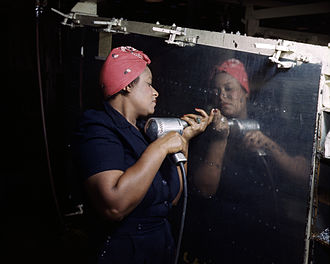United States home front during World War II






United States home front during World War II refers to the domestic, economic, social, and political conditions and activities in the United States during the period of World War II. This era was marked by significant changes and adaptations as the nation mobilized its resources and population to support the war effort against the Axis powers. The home front saw widespread changes in industry, labor, and society as a whole, with notable impacts on the role of women, racial minorities, and the economy.
Mobilization of the Economy[edit]
The U.S. economy underwent a dramatic transformation to meet the demands of the war. The War Production Board (WPB) was established to oversee the conversion of peacetime industries to war production. Factories that once produced consumer goods were now making war materials, such as tanks, planes, and ammunition. This shift led to a significant increase in industrial output and contributed to the Allied victory.
Labor and Employment[edit]
The war effort created a labor shortage as millions of American men enlisted in the military. This gap was filled by women and minority workers, leading to significant changes in the American workforce. The Rosie the Riveter campaign encouraged women to take on jobs traditionally held by men, marking a significant shift in gender roles. Additionally, the Executive Order 8802 was signed by President Franklin D. Roosevelt to prohibit racial discrimination in the national defense industry, leading to greater employment opportunities for African Americans and other racial minorities.
Rationing and Conservation[edit]
To ensure that sufficient resources were available for the military, the U.S. government implemented rationing of certain goods, including gasoline, rubber, metal, and foodstuffs. Citizens were issued ration books and encouraged to grow "victory gardens" to supplement their food supply. These measures were part of a broader conservation effort that also included recycling and energy conservation campaigns.
Civilian Morale and Propaganda[edit]
The U.S. government worked to maintain high civilian morale and support for the war effort through various means, including propaganda. The Office of War Information (OWI) was responsible for disseminating propaganda through posters, films, and radio broadcasts, emphasizing themes of patriotism, sacrifice, and the villainy of the Axis powers. Community and social organizations also played a role in supporting the war effort and maintaining morale on the home front.
Impact on Society[edit]
The war had profound effects on American society, including changes in family dynamics, as many women entered the workforce, and shifts in social attitudes towards women and racial minorities. The experience of working together for a common cause also contributed to a sense of national unity and pride. However, the war also exacerbated racial tensions in some areas, leading to race riots in cities such as Detroit and Los Angeles.
Post-War Impact[edit]
The end of World War II brought about a transition to peacetime economy and society, but the changes initiated during the war had lasting effects. The GI Bill helped veterans reintegrate into civilian life and spurred economic growth, while the experiences of women and minorities during the war laid the groundwork for future civil rights and feminist movements.
The United States home front during World War II was a period of profound change and adaptation. The collective efforts of the American people contributed significantly to the Allied victory and shaped the post-war world. The era remains a pivotal chapter in American history, reflecting the nation's capacity for mobilization, sacrifice, and transformation in the face of global conflict.
Ad. Transform your life with W8MD's Budget GLP-1 injections from $75


W8MD offers a medical weight loss program to lose weight in Philadelphia. Our physician-supervised medical weight loss provides:
- Weight loss injections in NYC (generic and brand names):
- Zepbound / Mounjaro, Wegovy / Ozempic, Saxenda
- Most insurances accepted or discounted self-pay rates. We will obtain insurance prior authorizations if needed.
- Generic GLP1 weight loss injections from $75 for the starting dose.
- Also offer prescription weight loss medications including Phentermine, Qsymia, Diethylpropion, Contrave etc.
NYC weight loss doctor appointmentsNYC weight loss doctor appointments
Start your NYC weight loss journey today at our NYC medical weight loss and Philadelphia medical weight loss clinics.
- Call 718-946-5500 to lose weight in NYC or for medical weight loss in Philadelphia 215-676-2334.
- Tags:NYC medical weight loss, Philadelphia lose weight Zepbound NYC, Budget GLP1 weight loss injections, Wegovy Philadelphia, Wegovy NYC, Philadelphia medical weight loss, Brookly weight loss and Wegovy NYC
|
WikiMD's Wellness Encyclopedia |
| Let Food Be Thy Medicine Medicine Thy Food - Hippocrates |
Medical Disclaimer: WikiMD is not a substitute for professional medical advice. The information on WikiMD is provided as an information resource only, may be incorrect, outdated or misleading, and is not to be used or relied on for any diagnostic or treatment purposes. Please consult your health care provider before making any healthcare decisions or for guidance about a specific medical condition. WikiMD expressly disclaims responsibility, and shall have no liability, for any damages, loss, injury, or liability whatsoever suffered as a result of your reliance on the information contained in this site. By visiting this site you agree to the foregoing terms and conditions, which may from time to time be changed or supplemented by WikiMD. If you do not agree to the foregoing terms and conditions, you should not enter or use this site. See full disclaimer.
Credits:Most images are courtesy of Wikimedia commons, and templates, categories Wikipedia, licensed under CC BY SA or similar.
Translate this page: - East Asian
中文,
日本,
한국어,
South Asian
हिन्दी,
தமிழ்,
తెలుగు,
Urdu,
ಕನ್ನಡ,
Southeast Asian
Indonesian,
Vietnamese,
Thai,
မြန်မာဘာသာ,
বাংলা
European
español,
Deutsch,
français,
Greek,
português do Brasil,
polski,
română,
русский,
Nederlands,
norsk,
svenska,
suomi,
Italian
Middle Eastern & African
عربى,
Turkish,
Persian,
Hebrew,
Afrikaans,
isiZulu,
Kiswahili,
Other
Bulgarian,
Hungarian,
Czech,
Swedish,
മലയാളം,
मराठी,
ਪੰਜਾਬੀ,
ગુજરાતી,
Portuguese,
Ukrainian
